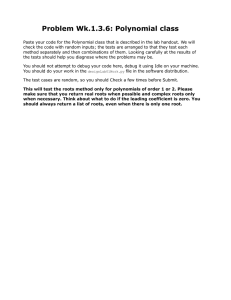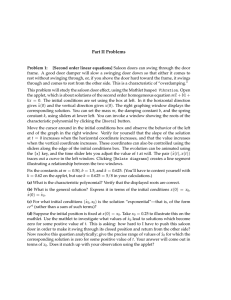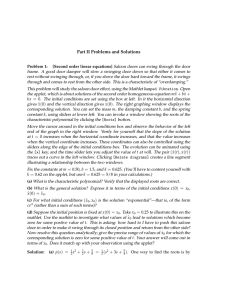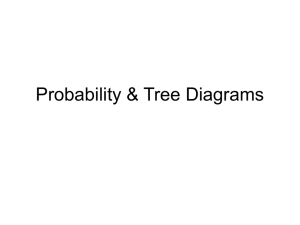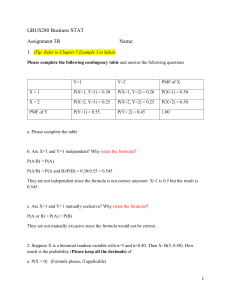18.03 Problem Set 3: Part ...
advertisement
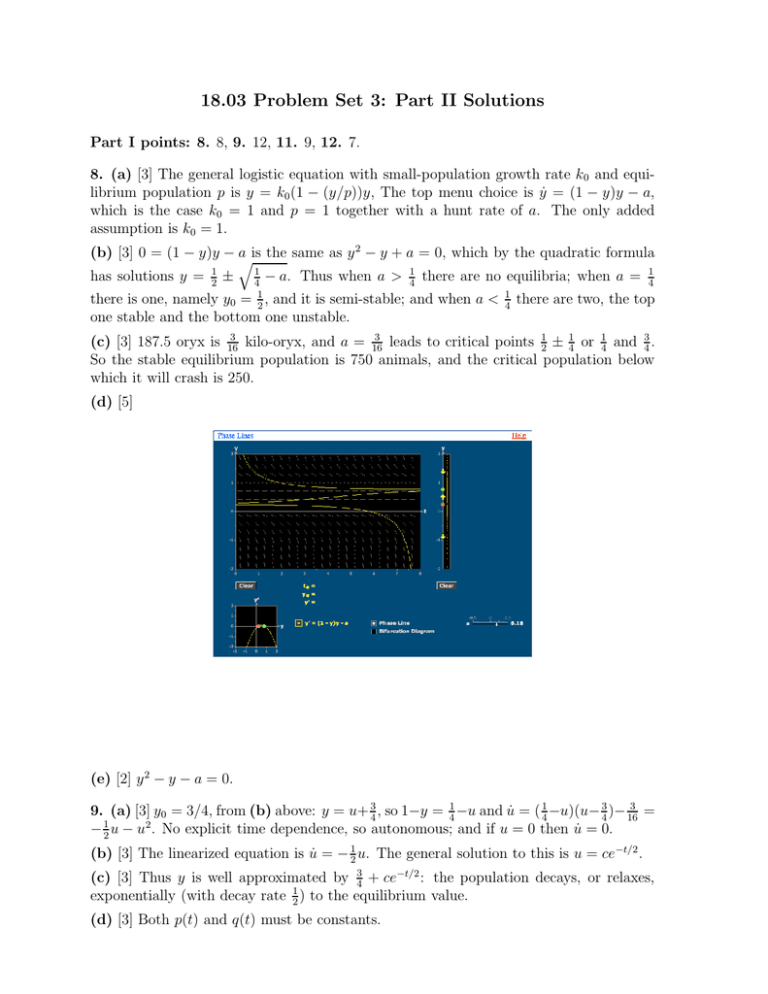
18.03 Problem Set 3: Part II Solutions Part I points: 8. 8, 9. 12, 11. 9, 12. 7. 8. (a) [3] The general logistic equation with small-population growth rate k0 and equi­ librium population p is y = k0 (1 − (y/p))y, The top menu choice is ẏ = (1 − y)y − a, which is the case k0 = 1 and p = 1 together with a hunt rate of a. The only added assumption is k0 = 1. (b) [3] 0 = (1 − y)y − � a is the same as y 2 − y + a = 0, which by the quadratic formula has solutions y = 1 2 1 − a. 4 1 y0 = 2 , and ± Thus when a > 1 4 there are no equilibria; when a = there is one, namely it is semi-stable; and when a < one stable and the bottom one unstable. 1 4 1 4 there are two, the top 3 3 (c) [3] 187.5 oryx is 16 kilo-oryx, and a = 16 leads to critical points 12 ± 41 or 14 and 34 . So the stable equilibrium population is 750 animals, and the critical population below which it will crash is 250. (d) [5] (e) [2] y 2 − y − a = 0. 3 9. (a) [3] y0 = 3/4, from (b) above: y = u+ 34 , so 1−y = 41 −u and u̇ = ( 41 −u)(u− 43 )− 16 = 1 2 − 2 u − u . No explicit time dependence, so autonomous; and if u = 0 then u̇ = 0. (b) [3] The linearized equation is u̇ = − 21 u. The general solution to this is u = ce−t/2 . (c) [3] Thus y is well approximated by 43 + ce−t/2 : the population decays, or relaxes, exponentially (with decay rate 21 ) to the equilibrium value. (d) [3] Both p(t) and q(t) must be constants. 11. (a) [4] p(s) = 12 s2 + 32 s + 58 = 12 (s2 + 3s + 54 ). One way to find the roots is by completing the square: s2 + 3s + 54 = (s + 32 )2 − 1, which clearly has roots − 23 ± 1, or − 21 and − 52 . This is what is shown on the applet. (b) [4] x = c1 e−t/2 + c2 e−5t/2 . So ẋ = − 12 c1 e−t/2 − 52 c2 e−5t/2 , and x0 = c1 + c2 , ẋ0 = − 12 c1 − 52 c2 . Thus x0 +2ẋ0 = −4c2 so c2 = − 14 (x0 +2ẋ0 ). Then c1 = x0 −c2 = 14 (5x0 +2ẋ0 ). (c) [3] x is purely exponential when either c1 = 0—so 5x0 + 2ẋ0 = 0—or when c2 = 0—so x0 + 2ẋ0 = 0. (d)[4] Try to solve for t in 0 = x(t) = c1 e−t/2 + c2 e−5t/2 . This leads to c2 /c1 = −e2t . This admits a solution for some t exactly when c1 and c2 are of opposite sign. To get positive t, you need c2 /c1 < −1: so either −c2 > c1 > 0 or −c2 < c1 < 0. In terms of x0 , ẋ0 , this says either x0 + 2ẋ0 > 5x0 + 2ẋ0 > 0, or x0 + 2ẋ0 < 5x0 + 2ẋ0 < 0, i.e. either x0 < 0 and ẋ0 > 52 (−x0 ), or x0 > 0 and ẋ0 < − 52 x0 . This is borne out by the applet. 12. (a) [6] p(s) = 21 (s2 + 2bs + 45 ) = 12 ((s + b)2 + ( 54 − b2 )) has a double root when � 5 = b2 or b = 25 . (We don’t allow b < 0.) Then the root is −b, so the general solution 4 is (a + ct)e−bt . � 19 (b) [6] When b = 14 , p(s) = 12 (s2 + 21 s + 54 ) = 12 ((s + 14�)2 + 19 ) has�roots −�14 ± �� i� 16� � 4 � 19 19 −t/4 −0.25 ± (1.0897)i. The general solution is thus e a cos 4 t + b sin 4 t = �� � Ae−t/4 cos 419 t − � . (Either form suffices.) (c) [5] My measurements are: 0.00, 2.93, 5.76, 8.69, 11.52. The successive differences are 2.93, 2.83, 2.93, 2.83—pretty close to constant. This is half the period of the sinusoid � 19 involved in the solution, which has circular frequency � = 4 and hence half-period � = �4�19 � 2.8829231. Not bad agreement! The oscillations are constant over time � (though the amplitude decreases). Successive differences of zeros of other solutions should be the same. MIT OpenCourseWare http://ocw.mit.edu 18.03 Differential Equations���� Spring 2010 For information about citing these materials or our Terms of Use, visit: http://ocw.mit.edu/terms.
